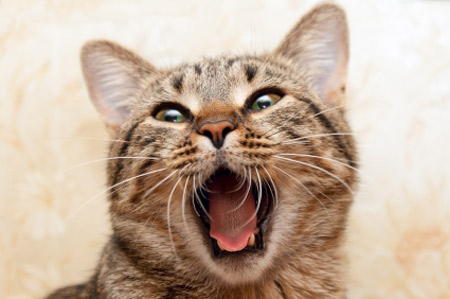
5. Kidney Disease or Chronic Renal Failure (CRF). CRF is normally the result of a gradual breakdown of the kidneys’ nephrons, tiny units that help filter and process waste. Because it occurs over time, CRF is hard to detect. Symptoms of CRF include frequent urination, extreme thirst, drooling, dehydration, weight loss and bad breath. If caught in the early stages, CRF can be managed with a progressive diet and prescription medications.
4. Urinary Tract Infection (UTI). This condition is characterized by blood in your kitty’s urine and pain when he or she has to go. Prolonged dehydration, cystitis, or a bacterial infection can result in a UTI. If you see your cat straining to urinate, or squatting and meowing in pain, take him or her to the vet; kitty may have a UTI.
3. Worms. Roundworms are among the most pervasive feline parasitic hosts and can be fatal to kittens. Even indoor cats can contract worms they venture onto worm-contaminated soil, or happen to eat an infected insect, rodent, or bird. Tapeworms are another nasty nuisance to our pets. A cat infected with tapeworms will experience lethargy, diarrhea, and weight loss. If you see rice shaped grains around your cat’s anus, kitty has tapeworms. An oral dewormer from your veterinarian can treat both types of worm.
 2. Gingivitis. Has your cat seen a dentist lately? When plaque, a mix of bacteria and food particles, festers along the gum line the result is gum inflammation, or gingivitis. Left untreated, the disease can lead to tooth loss and organ damage, as bacteria from the gums spreads through the bloodstream. Symptoms include reddened gums, bad breath, and pain or difficulty chewing.
2. Gingivitis. Has your cat seen a dentist lately? When plaque, a mix of bacteria and food particles, festers along the gum line the result is gum inflammation, or gingivitis. Left untreated, the disease can lead to tooth loss and organ damage, as bacteria from the gums spreads through the bloodstream. Symptoms include reddened gums, bad breath, and pain or difficulty chewing.
1. Upper Respiratory Infections (URI). Viruses and bacteria, especially the air-borne kind, can easily enter through your cat’s nose, throat and sinuses. Feline calicivirus and feline herpes are particularly contagious and nasty URIs. Vaccinations and an indoor life are a cat’s best defense against upper respiratory infections.
 SUNDAY, NOVEMBER 11, 2012 at 1:00 P.M.
SUNDAY, NOVEMBER 11, 2012 at 1:00 P.M. 






























